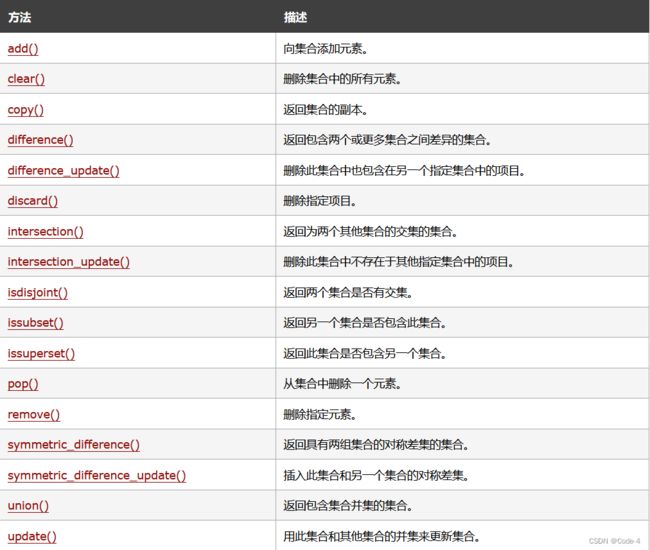Python集合(set)
目录
- 集合
-
- 创建集合
- 访问集合
- 向集合中添加和删除元素
- 集合的 交集,并集,差集运算
-
- **交集**
- **并集**
- **差集**
- 集合方法
集合
集合是无序和无索引的集合。在 Python 中,集合用花括号编写。
创建集合
创建集合:
thisset = {"a", "b", "c"}
print(thisset)
访问集合
您无法通过引用索引来访问 set 中的项目,因为 set 是无序的,项目没有索引。
但是您可以使用 for 循环遍历 set 项目,或者使用 in 关键字查询集合中是否存在指定值。
实例
遍历集合,并打印值:
thisset = {"a", "b", "c"}
for x in thisset:
print(x)
向集合中添加和删除元素
集合一旦创建,您就无法更改元素,但是您可以添加新元素。
添加元素
要将一个元素添加到集合,请使用 add() 方法。
要向集合中添加多个元素,请使用 update() 方法。
实例
使用 add() 方法向 set 添加元素:
thisset = {"a", "b", "c"}
thisset.add("d")
print(thisset)
实例
使用 update() 方法将多个元素添加到集合中:
thisset = {"apple", "banana", "cherry"}
thisset.update(["orange", "mango", "grapes"])
print(thisset)
删除元素
要删除集合中的项目,请使用 remove() 或 discard() 方法。
实例
使用 remove() 方法来删除 “b”:
thisset = {"a", "b", "c"}
thisset.remove("b")
print(thisset)
#如果要删除的项目不存在,则 remove() 将引发错误。
使用 discard() 方法来删除 “b”:
thisset = {"a", "b", "c"}
thisset.discard("b")
print(thisset)
#如果要删除的项目不存在,则 discard() 不会引发错误
集合的 交集,并集,差集运算
交集
intersection() 方法返回包含两个或更多集合之间相似性的集合。
含义:返回的集合仅包含两个集合中都存在的项目,或者如果使用两个以上的集合进行比较,则在所有集合中都存在
语法
set.intersection(set1, set2 ... etc)
实例
返回包含存在于集合 x 和集合 y 中的项目的集合:
x = {"a", "b", "c"}
y = {"s", "m", "a"}
z = x.intersection(y)
print(z)
并集
union() 方法返回一个集合,其中包含原始集合中的所有项目以及指定集合中的所有项目。
您可以指定任意数量的集合,以逗号分隔。
如果一项存在于多个集合中,则该项在结果中仅出现一次。
语法
set.union(set1, set2 ...)
实例
x = {"a", "b", "c"}
y = {"f", "d", "a"}
z = {"c", "d", "e"}
result = x.union(y, z)
print(result)
差集
symmetric_difference() 方法返回一个集合,其中包含两个集合中的所有项目,但不包含两个集合中都存在的项目。
含义:返回的集合包含两个集合中都不存在的项的混合体。
语法
set.symmetric_difference(set)
实例
返回一个集合,其中包含两个集合中的所有项目,但两个集合中都存在的项目除外:
x = {"a", "b", "c"}
y = {"s", "m", "a"}
z = x.symmetric_difference(y)
print(z)
